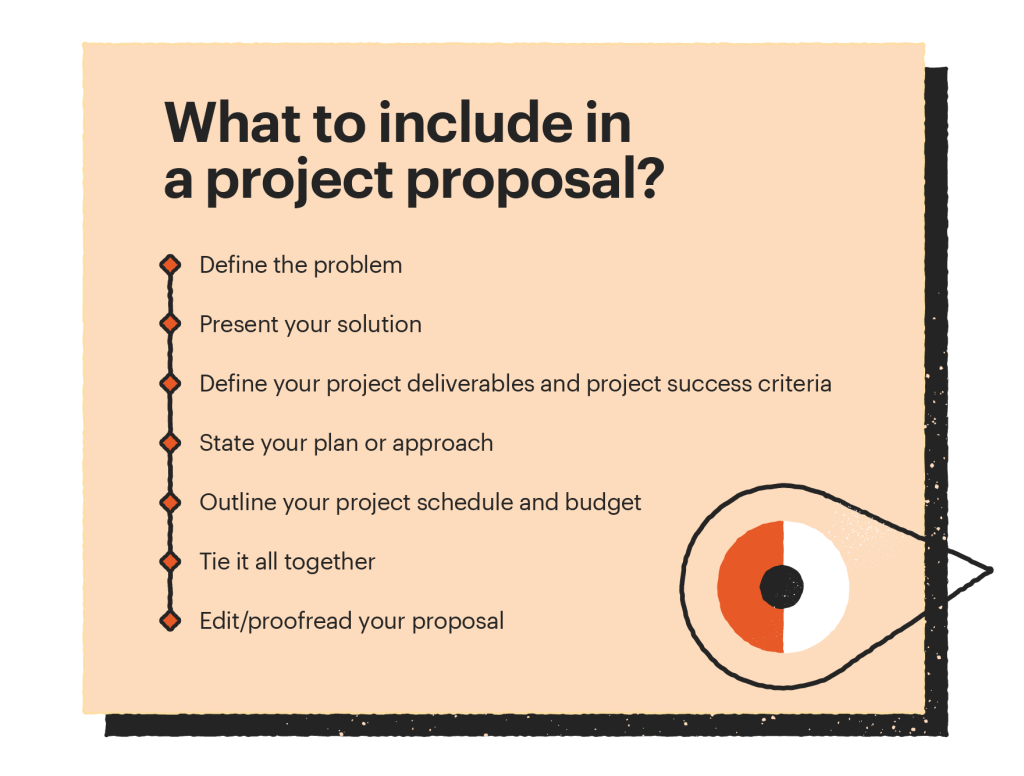A proposal is an initial document that outlines the most crucial framework for establishing the concept of the project. The proposal streamlines a professional relationship between outside stakeholders and your organization.
Typically, a project proposal includes an executive summary of your goals, i.e., what you want to accomplish, a description of objectives, and plans for achieving them.
How to write a winning project proposal
-
Things to consider before writing a project proposal
-
Define the problem
-
Present your solution
-
Define your deliverables and success criteria
-
State your plan or approach
-
Outline your schedule and budget
-
Tie it all together
-
Edit/proofread your proposal
-
Types of project proposals
-
Final thoughts
What is the purpose of a project proposal, and why do you need it?
Creating a proposal allows an organization to establish a formal, logical presentation to a project donor or an outside contributor/worker.
- The primary purpose of a proposal is to attract a sponsor (of sorts) to buy in into your new project/service/program.
- The project proposal is there to get all team members thinking in the same direction, set the same goals and priorities.
- Lastly, proposals are a great way to decide on new budget adjustments and overall pricing, hiring decisions, etc.
In 2021, thanks to advanced software solutions like PandaDoc, you can make the best use of project proposal templates that, in the case of Panda, come in 167+ samples.
Win over potential clients with a remarkable project proposal template and close your deals faster than ever!
Here’s an example of a Project Proposal Template solution you get with PandaDoc. It is clean, simple, and – most importantly – comprehensive, laying out everything you need to have in a project proposal template.
Other than getting a template with headings only (as is the case with some other solutions), PandaDoc comes equipped with appropriate descriptions and instructions that follow project proposal headings.
PandaDoc features project proposal templates filtered per category, too – all 97 of them! Each is useful for a particular segment/area and it’s up to you to pick yours.
What are the advantages of drafting a project proposal?
A project proposal is the sum of the initial steps to get the project running.
In that sense, drafting a clear project proposal early on comes attached to the following advantages:
- Clear proposals increase clarity concerning project requirements and roadmap.
- They prove the feasibility and practicality of a project or program.
- Clear proposals play an integral part in reducing misalignment since the base structure and organization are established upfront.
- Successful proposals lead to organizational growth, new client adoption, and project replication.
- They increase credibility and exposure in the community while building alliances with stakeholders and.
- A good project proposal drives innovation that is good for the business of stakeholders and the wider public.
- Project proposals anticipate and solve problems early as they expose a project’s planning to a new audience with a fresh perspective on the laid out problem.
- Proposals become valid planning documents when integrated into day-to-day work. They can also become helpful templates for project implementation.
It’s essential your proposal grabs the decision-maker’s attention and that it gets delivered with clarity and confidence. If you believe in your project, it’ll show in your proposal.
If you are, at this time, unsure of how to create a project proposal or you would rather play safe and go for a project proposal template that was already professionally put together, PandaDoc is the word!
Need an NGO Project proposal template or an Architectural one? Looking for a free Grant proposal template that’ll help you put your grant proposal together in a jiffy? Look no further, ‘cos Panda has them all, and more!
What a project proposal is not?
A project proposal is not a contract, so it’s crucial not to confuse it with a business proposal.
Unlike a business proposal that outlines legal terms and conditions for acquiring a product/service, sponsors sign the project proposal to approve its contents.
Once the proposal is signed and approved, a business starts drafting a contract in addition to items such as a project plan, project charter, project timeframe, and similar.
Things to consider before writing a project proposal
Before starting on your next project proposal outline, make sure you consider the following:
- Identify your target audience as they are your primary decision-makers.
- Focus on the type of relationship you are looking to cultivate with them and think of ways to accomplish that.
Here are some questions to ask yourself before writing your project proposal:
- How familiar is your audience with the proposed project scope? What do they (don’t) know?
- What do they want to hear? What would be the best way to communicate your idea so it’s understood easily?
- Does your proposal need to provide background information and supplemental material on a particular topic?
Potential drawbacks and pitfalls
In his paper Selling your project proposal: the art and science of persuasion*, McNamara, F. L. (2012) says that
“the proposal selling process can be difficult without a complete understanding of persuasion psychology, organizational culture and politics”.
McNamara further emphasizes that “project approval and allocation of project resources does not always follow a purely logical selection process”.
He also stresses that “these decisions are made by people who use both their logical and intuitive/emotional minds to make decisions”.
Citing McNamara, we’ll say that the root cause why proposals of the project get rejected within organizations comes down to these four points:
- The proposal is poorly defined
- The proposal is not aligned with the goals of the organization
- The proposal does not clearly and credibly define the benefits of the project
- The proposal is not effectively presented and sold
Conclusively, if your project proposal gets rejected, that doesn’t necessarily mean it was bad – it means it most probably lacked clarity and persuasiveness.
* McNamara, F. L. (2012). Selling your project proposal: the art and science of persuasion. Paper presented at PMI® Global Congress 2012 — North America, Vancouver, British Columbia, Canada. Newtown Square, PA: Project Management Institute.
Data and research
For your proposal to justify its existence and potentially get the green light, you need facts, graphs, figures, and charts sensibly lined up.
Do some research on (un)successful past projects to gather as much complex data, evidence, and examples as possible.
Examine previous case studies to be able to compare them with your present project objectives and proposed solution. All this knowledge you find should help you create a good project proposal with a successful outcome.
What is a request for proposal (RFP)?
As defined by Investopedia, “a request for proposal (RFP) is a document that announces a project, describes it, and solicits bids from qualified contractors to complete it.”
For most organizations, a request for proposal is a common way of launching projects, and many governments use them routinely as well.
When using an RFP, “the entity requesting the bids is responsible for evaluating the feasibility of the bids submitted, the financial health of the bidding companies, and each bidder’s ability to undertake the project”, explains Investopedia.
How to write a project proposal?
Remember your primary reason for writing a project proposal: convince key people to support your next project and obtain the executive buy-in for it.
You need decision-makers hooked on your idea, so much so that they’ll feel motivated to greenlight the project.
If this is the first time you are handling project proposals, go for a PandaDoc project proposal template to avoid potential mistakes and deliver a professional solution that will make you look good with your clients.
What to include in a project proposal?
No matter how enthusiastic and well-spoken you are, a project proposal must follow a specific structure.

Step 1. Define the problem
What problem is your project trying to address, and what’s making it a problem in the first place? Is this issue worth solving?
In presenting the problem, start strong; describe your project pain point succinctly in a way it resonates with your target audience.
Although it is important to make the audience see the problem the way you see it, use facts instead of opinion.
Rely on the data you’ve gathered through research.
Step 2. Present your solution
Make your audience see your way of solving this problem is better than everyone else’s; show/explain why other solutions won’t work and guide them through your problem-solving process.
When talking about solutions, anticipate questions and objections and be ready to defend your solution.
Give your best to paint a picture where the audience understands the solution’s larger impact. Once again, facts and research-backed examples are your friends.
Step 3. Define your deliverables and success criteria
This part of your project proposal is reserved for clarifying the functions and attributes of the deliverable to your audience and explaining why you are sure the project will be successful.
For the stakeholders to take you seriously, define what your project will deliver and include a delivery date of each deliverable.
Your solution must be SMART (specific, measurable, achievable, realistic, and time-bound) to win them over.
Step 4. State your plan or approach
This is the most significant section of the proposal as it discusses how to achieve the project’s objectives.
Start with an explanation of the project background, your intended approach and why it’s relevant and effective.
Use this section to introduce project strategies and compartmentalize your project approach.
Explain the following:
- Will you be using in-house staff, third-party contractors, or consultants? Why?
- How do you plan to allocate responsibilities?
- Do you find the traditional waterfall approach constructive or not? Will you be using it?
This is your chance to discuss the “why” behind every decision on the table.
Step 5. Outline your schedule and budget
This is the section where you break your budget down into categories (tools, supplies, etc.) and include both direct and indirect costs.
The key is to provide as much detail as possible so the stakeholders see you’ve done your research.
Outline your project schedule as precisely as possible: convey project lifecycle by concretely communicating start and end times.
Don’t guess. Also, if certain project sections can be done simultaneously, include that in your proposal, too.
Step 6. Tie it all together
The conclusion of your proposal should briefly recap the problem, solution, and benefits.
Emphasize the parts of your proposal you want your audience to remember by restating crucial ideas or facts and their solutions.
Before submitting/presenting the proposal in real-time, check it for the consistency of ideas, and make sure it has a pleasant, easy-to-follow flow.
It should tell a story, and make a cohesive whole out of all sections.
Try not to include elements that don’t contribute to the overall project objectives or seem off for any reason. Ensure all the necessary elements of your proposal have been addressed.
Step 7. Edit/proofread your proposal
Make the necessary edits to your proposal to make it clear, helpful, and persuasive.
Ensure the proposal is attractive, organized, and visually appealing.
Check the tone and language. And don’t forget to proofread for grammar, punctuation, or spelling mistakes. Ask for feedback.
Use a template to help everyone’s proposals cover the significant bits and manage expectations for readers.
Unless the template already features it, insert the table of contents yourself to help set your audience up mentally for what they’re about to read.
Types of project proposals
These 5 are the most common types of project proposals segmented by their different goals and requirements.
1. Formally/informally solicited project proposals
A formally solicited proposal comes with specific directions. It is done is in response to an RFP (Request for proposal) and is often initiated by project managers.
If a formal project proposal is well-written, there’s a high chance that it’ll be approved.
An informally solicited project proposal is usually requested verbally or via an informal communication channel, making it, perhaps, the trickiest type of project proposal to write.
As it doesn’t come with as much context as the formal one, the proposal writer and its project team will have to do a lot of research to get someone else’s idea approved.
2. Unsolicited project proposals
An unsolicited project proposal format is one that no one asked for but they potentially want it.
They usually come from those “Aha” moments we have throughout the workday. Essentially, they are more complex than an elevator pitch but less serious than solicited proposals.
To get this type of proposal approved, you’ll need to do a lot of work, but it could have a great impact on your business.
3. Continuation project proposals
Continuation project proposals are usually done on a calendar basis and are considerably lower lift proposals as the project had already been approved.
This type of project proposal is conducted when a project enters a new phase or new resources/budgets are needed to guarantee the continuance of a project.
4. Renewal project proposals
Marginally different from a continuation project proposal, renewal project proposals are written when a project has ended and needs to start again.
You’ll typically use the success data of the previous project for any (new) research for this renewal proposal.
5. Supplemental project proposals
Supplemental project proposals are written when you need more resources than you’d initially requested or have gone over budget on your project.
Final thoughts
Every project proposal is a mini project in itself.

Still, make sure you follow the preliminary steps mentioned above first, whether you are using a standard process checklist or project management software.
Looking For Document Management System?
Call Pursho @ 0731-6725516
Check PURSHO WRYTES Automatic Content Generator
https://wrytes.purshology.com/home
Telegram Group One Must Follow :
For Startups: https://t.me/daily_business_reads





